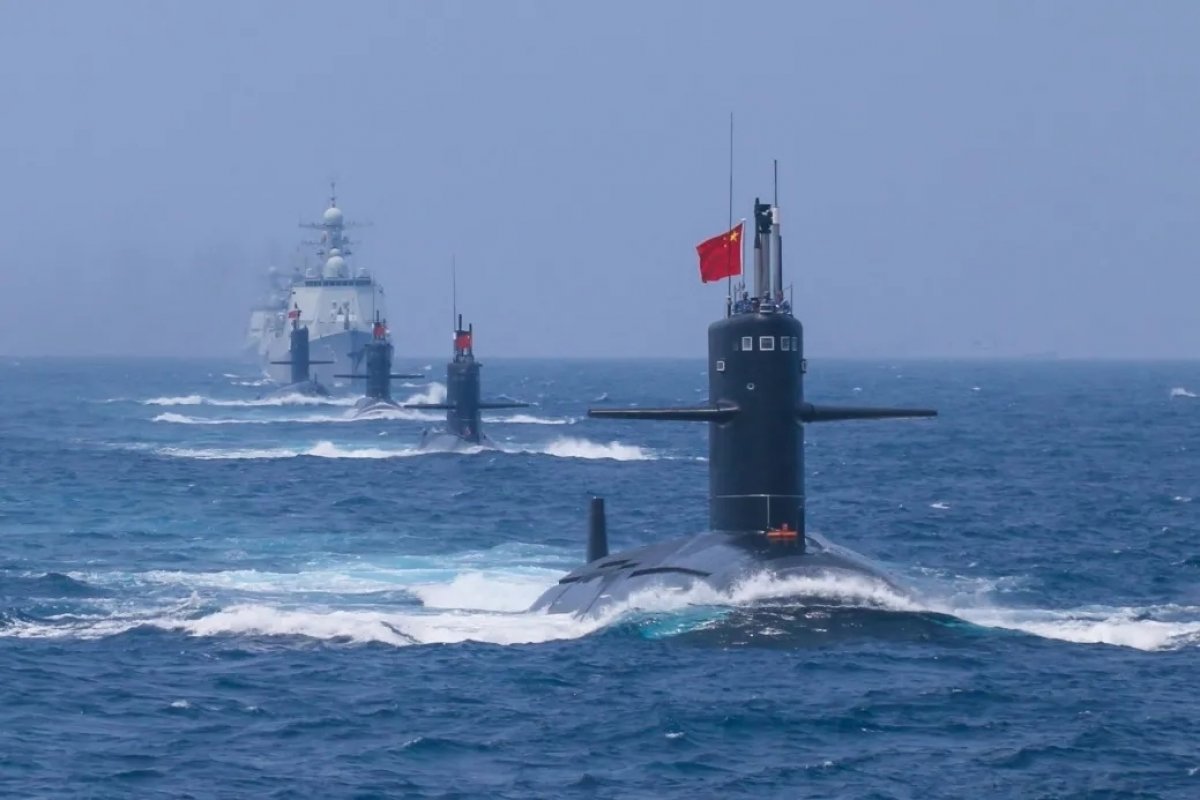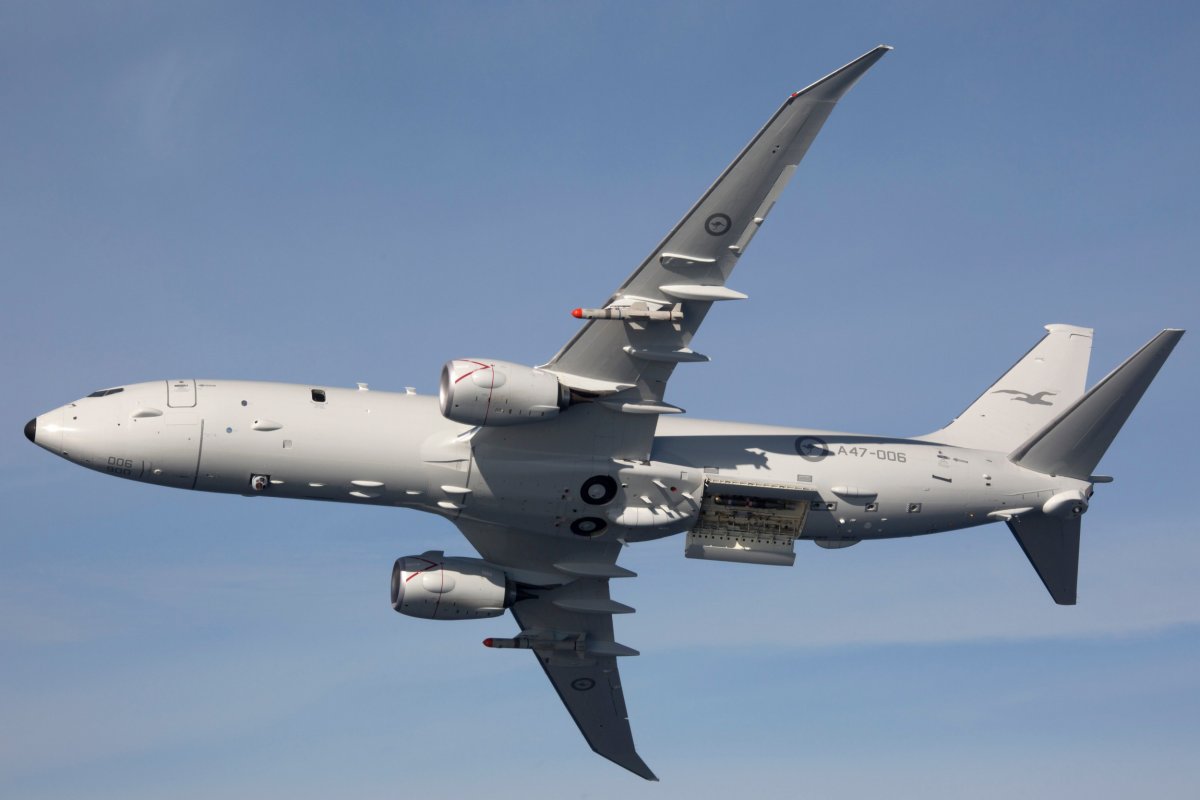China's push for mass military modernization includes new, more advanced submarines to add to the world's largest navy, causing U.S. partners in the region to scramble to acquire new capabilities of their own.
Their answer to the rising underwater threat is a passenger plane-sized submarine killer called the P-8 Poseidon, and orders for the aircraft are pouring in from countries like Australia and India. Both are members of the Quadrilateral Security Dialogue, which also includes the U.S. and Japan as part of a quasi-alliance that seeks to enforce a "free and open Indo-Pacific."
And countries as far away as Germany, Norway and the United Kingdom have also purchased the aircraft.
One senior Pentagon intelligence official said it's no coincidence that countries were buying up the anti-submarine warfare platform.
"China is expanding their undersea warfare capability to extend beyond the South China Sea, which presents a strategic threat to not only nations with territorial disputes, but throughout the entire Pacific area," the official told Newsweek. "It is essential for the national security of partner nations to have the ability to detect and monitor Chinese submarines. The P-8 Poseidon is the best capability to perform that task."
"With an advanced anti-submarine warfare suite," the official added, "the P-8 is the best answer to countering Chinese submarines."
A spokesperson for Boeing, the U.S. aerospace company that produces the P-8 and its submarine-fighting P-8A variant, said the aircraft was "deployed around the world, with more than 135 aircraft in service, and over 400,000 collective mishap-free flight hours."
But even with these new capabilities in stock, China's prowess continues to multiply, presenting a formidable competitor as tensions simmer across the seas of Asia.

The U.S. military's latest assessment of Chinese military power, published in September 2020, estimated that China had 50 diesel-powered attack submarines, six nuclear-powered attack submarines and four nuclear-powered ballistic missile submarines. The U.S. is estimated to possess roughly 68 submarines, all nuclear-powered, but China's fleet is expanding rapidly.
The report described submarine development as a "high priority" for the People's Liberation Army Navy, and estimated that the force "will likely maintain between 65 and 70 submarines through the 2020s, replacing older units with more capable units on a near one-to-one basis."
China has set out to update two key submarine models, the Xia-class Type 092 and the Jin-class Type 094, according to a report published last month by French submarine expert Eric Genevelle and retired U.S. Navy submarine sonar technician Richard W. Stirn.
This campaign includes vessels equipped with nuclear-capable submarine-launched ballistic missiles (SLBMs), as well as an array of other weapons such as anti-ship missiles and torpedos. The latest Chinese SLBM, known as JL-2A, has a range of nearly 8,600 kilometers, more than 5,340 miles, putting potential targets as far as the U.S. mainland within range, as estimated in Genevelle and Stirn's paper.
China's submarine fleet serves another important strategic function.
These quiet undersea craft traverse the depths largely undetected, making them ideal for gathering intelligence as they conduct missions as far out as the Indian Ocean. They also can serve to fortify Beijing's broad territorial claims across geopolitically sensitive spots in the South China Sea and East China Sea, where Japan last month sent both warplanes and warships in response to a suspected Chinese submarine spotted too close for Tokyo's comfort to islands claimed by both countries.
With the U.S. and partnered nations seeking to challenge China's version of the world map, the People's Republic views submarines as a key asset. Using advanced monitoring equipment, China seeks to establish what it refers to as a "Great Underwater Wall" to keep tabs on some of the world's busiest waterways in the South China Sea.
Combined with an even more potent surface force, this project has helped fuel the rush for the P-8, a plane best known for its premier reconnaissance capabilities.
"I think the purchase of P-8 maritime patrol aircraft by international partners is as much a testament to the P-8's multi-role maritime patrol capabilities as it is to the growing naval threat from China," Eric Wertheim, editor of the Naval Institute Guide to Combat Fleets of the World, told Newsweek.
"The P-8s are indeed capable submarine hunters," he added, "but they are also a potent tool for any type of marine domain awareness, intelligence surveillance and reconnaissance, and anti-ship/anti-surface operations, just to name a few important naval missions for the P-8."
Wertheim described the P-8 as a remarkably versatile aircraft.
"The P-8 has very capable radar and other sensors that make it valuable for tracking submarines, but also tracking surface assets as well," he said. "The aircraft can also carry a wide array of weapons including torpedoes and cruise missiles."
Wertheim said that "while the threat of Chinese submarines is certainly growing" for regional countries using the P-8, like Australia, India, New Zealand and South Korea, he argued that "so is the threat from Chinese surface ships and other naval assets, and the P-8 is an important tool in helping deal with any potential naval threats."
In addition, he said the aircraft "are also very useful for peacetime activities and can be invaluable assets for humanitarian assistance operations and research-and-rescue duties as well."
But China's anti-aircraft options have also expanded.
The People's Liberation Army has deployed surface-to-air missile systems not just on the mainland but also on islands in the middle of the South China Sea. Warships also have P-8s in their sights, as evidenced by last year's February incident in which the U.S. Navy accused the crew of a Chinese destroyer of shining a laser on one of the Pentagon's top-of-the-line aircraft.
Beyond acquiring the P-8, a number of U.S. partners are also shaping up their own submarine fleets to adapt to the modern maritime military environment. In fact, both the U.S.-aligned bloc and China appear to be caught in a cycle of weapons development in which Hu Bo, director of China's South China Sea Probing Initiative, felt Beijing had the upper hand.
"The underwater arms race in the Asia-Pacific is intensifying, and similar operations by the U.S. and others will only spur China to invest more in the underwater sector," Hu told Newsweek. "Given China's extraordinary capacity for national mobilization, the result of China's input could be even more challenging for the United States, which may run counter to current American policy expectations."
"The great development of China's surface forces in the past 20 years have fully illustrated this point," he added.

Yet the race goes on.
Australia, the U.K. and the U.S. announced a new alliance last month, along with plans to help Australia develop its first nuclear-powered submarine. The news drew quick condemnation from China, which accused the trio of pursuing destabilizing moves in the region. France issued immediate protests as the agreement effectively scrapped an ongoing multibillion-dollar French deal to develop such a vessel for Australia.
Also last month, U.S. ally South Korea debuted its SLBM capacity, becoming the first non-nuclear nation to enter this realm. Weeks later, rival North Korea launched an SLBM, demonstrating that the nuclear-armed state was also investing in undersea warfighting capabilities.
"Our ministry keeps monitoring the North Korea military situation, including its submarine activity, closely," a South Korean National Defense Ministry spokesperson told Newsweek.
While maintaining a robust alliance with Washington, Seoul has increasingly sought to balance that relationship with its ties to Beijing. It has also measured deterrence and diplomacy with North Korea, an ally of China.
When it comes to the underwater domain specifically, Blake Herzinger, a fellow at the Hawaii-based Pacific Forum research institute who served as an intelligence officer for a P-8 squadron that also included the plane's predecessor, the P-3, told Newsweek that South Korea "is far more concerned about North Korean submarines than they are about those of the People's Liberation Army Navy."
However, he noted that China's "goal of bolstering its blue water capabilities will likely encourage the PLAN to continue sending its submarines farther abroad." And for others in the region, "if that presence continues to increase, or becomes persistent, states further from China's coastline, like India, Australia, and New Zealand, would likely perceive a significantly greater threat," Herzinger argued.
A spokesperson for the Australian Defense Department, who said the P-8A "has has performed at a level beyond initial expectations," told Newsweek that the department "closely monitors military capability developments within the region, including those of China."
"Australia wants to see China exercise its power in a way that enhances stability, and reinforces the international rules based order, the spokesperson said. "As China further modernises its forces, it should be transparent about its capability and intentions. This will provide assurance to the region and the international community that it is not seeking to undermine the secure, stable and peaceful region from which we have all benefited – including China."
Much focus has been given recently to China's other myriad military achievements, marked most recently by reports in the Financial Times of two hypersonic missile tests said to have been conducted over the summer.
This side of the next-generation arms race does evoke classic Cold War fears, but as the U.S.-China rivalry plays out today primarily on open waters, the still mostly unseen threat of the submarine continues to top the list of concerns for sailors on the frontline.
"In very general terms, and in all submariners' fondest dreams, submarines are certainly a threat both in terms of surveillance and kinetic maritime threat," Herzinger said.
Reciting what he called "an old adage," Herzinger said, "There are are only two types of ships: submarines and targets."
Uncommon Knowledge
Newsweek is committed to challenging conventional wisdom and finding connections in the search for common ground.
Newsweek is committed to challenging conventional wisdom and finding connections in the search for common ground.
About the writer
Newsweek editor at large; former FBI double agent and the author of "How to Catch a Russian Spy"
To read how Newsweek uses AI as a newsroom tool, Click here.








